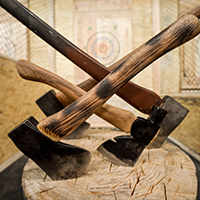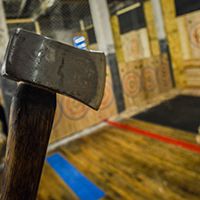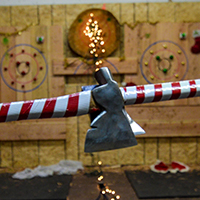How To Throw An Axe: NATF Style
Sections
How To Videos:
How To Throw An Axe: NATF Style
Where To Stand

When setting up to throw, a players lead foot may be on top, beside, behind, or in front of the black line:
At that point, their back foot must be planted completely behind the black line; The back foot may be planted off center to the left or right of the black line, as long as it is still entirely behind the back of the black line in relation to its distance from the target.
Once the motion to throw the axe has begun, the player may take a full step forward bringing their rear foot to the front of their body and planting it as the motion to throw continues:
This foot that has now moved from the back of the player to plant on the floor in front, once planted, must not leave the ground again until the axe has left the hand of the player and has been thrown; During the motion of the throw, any steps taken before crossing the back plane of the black line do not count towards the legal step count.
2 Handed Throw

The 2 handed throw is the most basic and usually what people start with when picking up axe throwing. It allows you to easily adjust your throw and achieve reliable accuracy quickly due to the control that is provided by utilizing your second hand for guidance.
1 Handed Throw

Most league throwers switch over to the 1 handed throw. This allows you to get your throw down to a very simple single motion and minimizes the chances for mistakes because there is less motion that needs to be the same for every throw.
Adjusting Your Throw

One of the most important things to learn when throwing axes is how to adjust your throw based on how your axe is landing. Watch this section to understand exactly how you need to move your feet or hand positions to get the axe to do exactly what you need it to.
New Boards

New boards can be a huge pain to new throwers and veterans. Since the board is fresh and has not been broken in by other axes it will require some water to soften up the wood and allow your axe to split the grain much easier. A dry board will cause axes to bounce much more often than a soaked board.






